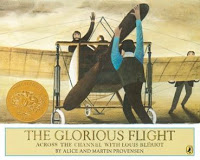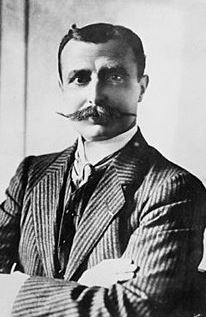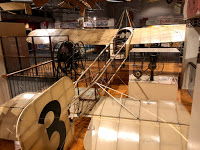If you’ve stumbled here from Pinterest, or some other site … welcome! While each of these books/lessons can stand alone, they are also a part of a year-long series that we have taught at our homeschool co-op. Each lesson builds in part on the one before. Some stories also have similar themes with the books that go before/after them. If you are interested in more information, or to see the complete booklist, check out my main page, More FIAR – Inspired Literature-Based Lesson Plans, especially for homeschool and homeschool co-ops. Thanks for looking around, and welcome to the site!
The Glorious Flight – Across the Channel with Louis Bleriot
by Alice and Martin Provensen
Things I Need:
- The Glorious Flight Book
- The Glorious Flight Handwriting Sheet
- Map of the World (showing England)
- Map of England (close up, showing the English Channel)
- Plane printout (cut into separate planes)
- Tape or Sticky Tack
- Inspiration Handout
Review:
- Who can find New England (from Cranberry Thanksgiving)
- Who can find Virginia (from All Those Secrets of the World)
- Who can find Japan, located on the continent of Asia (from Grandfather’s Journey)
- Who can find the Appalachian Mountains (from Daniel’s Duck, Amber on the Mountain, and When I Was Young in the Mountains)
Introduce the Story:
Have we always been able to fly?
Today’s story is called, The Glorious Flight.While we read the story today, we are going to be looking for two things:
1) We’re going to try to find how many tries it took before Mr. Bleriot could fly his airplane.
2) We’re going to try to pay attention to descriptive words that the authors use in the story, to help make the story more interesting.
For more history of Louis Bleriot, this YouTube clip, below has a lot of great pictures and stories from his early life.
While Reading the Story:
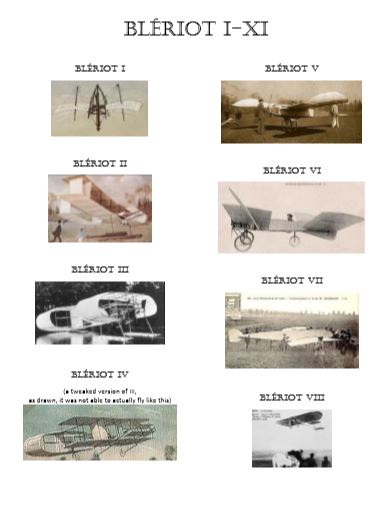 |
| Click here for printable version |
After the Story:
- Next, ask the class – did Mr. Bleriot give up?
- What was it that made him want to try flying in the first place? (Inspired by airship)
- What was it that helped him succeed? (Diligence, hard work)
If you’d like – this is a perfect place to introduce Thomas Edison’s famous quote,
“Genius is 1% inspiration and 99% perspiration.”
Many people can have a good idea. Very few are willing to put in the time and effort to make it work.
Now its your turn – descriptive writing exercise
Tell the class to choose something they want to describe.Now, draw this thing, and write a few words (or sentences, depending on ability) to describe it. If they aren’t able to write at all, encourage them to draw their “description” or help them to spell the words. The point of this exercise isn’t to get them spelling or writing correctly, but to encourage them to see something, and be able to describe it.
Choose several objects in the classroom, and use many words to describe that object.
You could say … “Shoe”, or you could say, “Beautiful, Pink, Sparkly Shoe”.
You could say … “Chalk”, or you could say, “Light, Weightless, Dusty, Dry Chalk”.
For an example from the book, use the author’s description of the flying over the English Channel,
You could say … “English Channel”, or you could say,
“Twenty miles wide.
Black, tossing waves.
Fog and rain.
A very cold bath.
A long swim.
It is a dangerous prospect.”
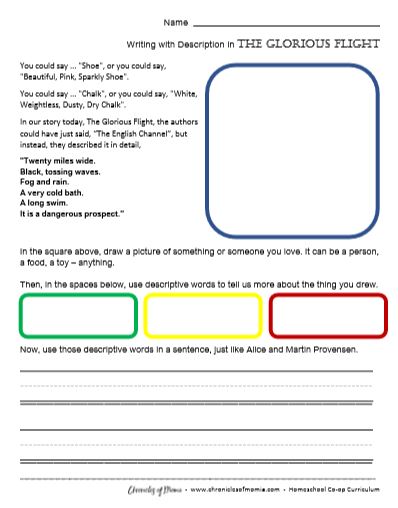 |
| Click here to print |
Handwriting Verse:
For this weeks handwriting assignement, we used the verse from Proverbs 24:16, “the righteous falls seven times, yet rises up again.” First off, this is a wonderful verse to have memorized and if you have an extra few moments to help your students memorize it – excellent. But if you’re just using it as copy work, that’s okay too. Take a moment to share something about this verse.
Did Mr. Bleriot give up his first try? No he failed. And he failed on his second try. And his third. Etc. (If you have read the book Mirette on the High Wire you also can bring in that example as well) It wasn’t until his 11th Try that he succeeded … so if you fail. or fall down … don’t worry. Don’t give up. Even the best of men fail many times – BUT, they the get up again!
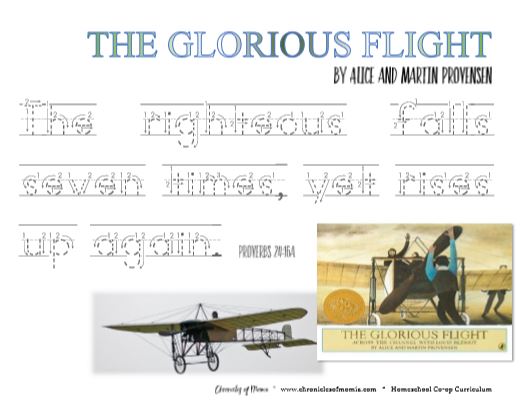 |
| Click here to print
|
Extra Stuff …
Or, you can check out the complete Learning the ABC’s through Literature Series, which is a similar series that we did with this same group of kiddos a year earlier. Both of these series of books have been inspired by the Five in a Row curriculum, with many of the books being the same. The ideas, implementation of it for a co-op, and printables are all my own, unless otherwise indicated. Thanks for stopping by to check it out!

